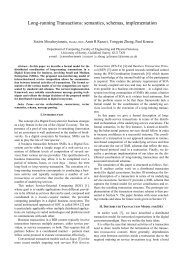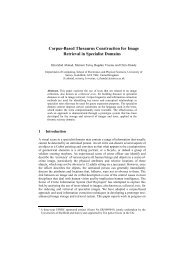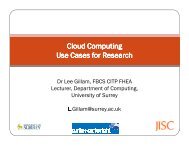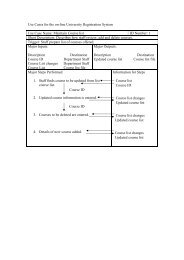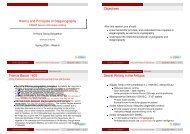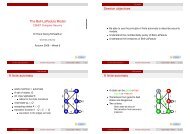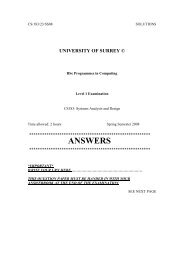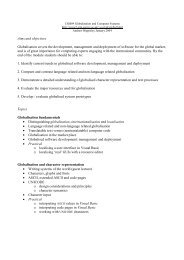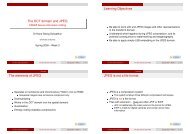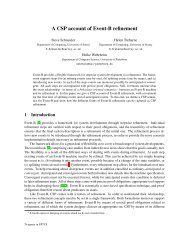Anonymous Connections and Onion Routing
Anonymous Connections and Onion Routing
Anonymous Connections and Onion Routing
Create successful ePaper yourself
Turn your PDF publications into a flip-book with our unique Google optimized e-Paper software.
PaulF.Syverson, David M. Goldschlag, <strong>and</strong> Michael G. Reed, \<strong>Anonymous</strong> <strong>Connections</strong> <strong>and</strong> <strong>Onion</strong> <strong>Routing</strong>" to appear 1997 IEEE<br />
Symposium on Security <strong>and</strong> Privacy<br />
<strong>Anonymous</strong> <strong>Connections</strong> <strong>and</strong> <strong>Onion</strong> <strong>Routing</strong><br />
Paul F. Syverson, David M. Goldschlag, <strong>and</strong> Michael G. Reed <br />
Naval Research Laboratory<br />
Abstract<br />
<strong>Onion</strong> <strong>Routing</strong> provides anonymous connections<br />
that are strongly resistant to both eavesdropping <strong>and</strong><br />
trac analysis. Unmodied Internet applications can<br />
use these anonymous connections by means of proxies.<br />
The proxies may also make communication anonymous<br />
by removing identifying information from the<br />
data stream. <strong>Onion</strong> routing has been implemented on<br />
Sun Solaris 2.X with proxies for Web browsing, remote<br />
logins, <strong>and</strong> e-mail. This paper's contribution is a detailed<br />
specication of the implemented onion routing<br />
system, a vulnerability analysis based onthisspecication,<br />
<strong>and</strong> performance results.<br />
1 Introduction<br />
Private electronic communication is becoming an increasingly<br />
important public issue. Encryption can effectively<br />
hide the content of a conversation from eavesdroppers,<br />
<strong>and</strong> this protection is being integrated into<br />
many systems. But, hiding the identities of communicating<br />
parties from eavesdroppers, or from each other,<br />
is usually not considered.<br />
Who is communicating with whom, however, may<br />
be sensitive too. E-mail users may wish to hide their<br />
addresses. <strong>Anonymous</strong> cash is not anonymous if the<br />
communications channel identies the purchaser. The<br />
amount of information revealed through Web browsing<br />
should be deliberate. Inter-company collaboration<br />
may be condential. Revealing identities in a cellular<br />
phone system reveals a user's location, since the cellular<br />
phone network must track h<strong>and</strong>sets' locations.<br />
A purpose of trac analysis is to reveal who is talking<br />
to whom. The anonymous connections described<br />
here are designed to be resistant to trac analysis, i.e.,<br />
to make it dicult for observers to learn identifying in-<br />
Address: Naval Research Laboratory, Center For High Assurance<br />
Computer Systems, Washington, D.C. 20375-5337, USA,<br />
phone: +1 202.767.2389, fax: +1 202.404.7942, e-mail: flast<br />
nameg@itd.nrl.navy.mil.<br />
formation from the connection (e.g., by reading packet<br />
headers, tracking encrypted payloads, etc.). Any identifying<br />
information must be passed as data through<br />
the anonymous connections. Our implementation of<br />
anonymous connections, onion routing, provides protection<br />
against eavesdropping as a side eect. <strong>Onion</strong><br />
routing provides bidirectional <strong>and</strong> near real-time communication<br />
similar to TCP/IP socket connections [6].<br />
The anonymous connections can substitute for sockets<br />
in a wide variety of unmodied Internet applications<br />
by means of proxies. The proxies may also remove<br />
identifying information from the data stream, to make<br />
communication anonymous too.<br />
Although onion routing may be used for anonymous<br />
communication, it diers from anonymous remailers<br />
[7, 11]intwo ways: Communication is realtime<br />
<strong>and</strong> bidirectional, <strong>and</strong> the anonymous connections<br />
are application independent. <strong>Onion</strong> routing's anonymous<br />
connections can support anonymous mail as well<br />
as other applications. For example, onion routing may<br />
be used for anonymous Web browsing. Ausermay<br />
wish to browse public Web sites without revealing his<br />
identity to those Web sites. That requires removing<br />
information that identies him from his requests to<br />
Web servers, <strong>and</strong> removing information from the connection<br />
itself that may identify him. Hence, anonymous<br />
Web browsing uses anonymized communication<br />
over anonymous connections. The Anonymizer [1] only<br />
anonymizes the data stream, not the connection itself.<br />
So it does not prevent trac analysis attacks like trackingdataasitmoves<br />
through the network.<br />
A preliminary description of onion routing is found<br />
in [10, 13]. Those papers mainly present the goals of<br />
onion routing, <strong>and</strong> some of the basic structure of our<br />
solution. However, they do not give enough detail to<br />
properly evaluate the security of onion routing. The<br />
original content of this paper includes: a detailed specication<br />
of the onion routing system a description of<br />
implementation choices that were inuenced by considerations<br />
not apparent at a more abstract level a<br />
vulnerability analysis based on the specication <strong>and</strong><br />
performance results for our prototype. The speci-<br />
1
PaulF.Syverson, David M. Goldschlag, <strong>and</strong> Michael G. Reed, \<strong>Anonymous</strong> <strong>Connections</strong> <strong>and</strong> <strong>Onion</strong> <strong>Routing</strong>" to appear 1997 IEEE<br />
Symposium on Security <strong>and</strong> Privacy<br />
cation presented here is sucient to guide both reimplementations<br />
<strong>and</strong> new applications of onion routing.<br />
This paper is organized in the following way. Section<br />
2 presents an overview of onion routing. Section<br />
3 presents empirical data about our prototype. Section<br />
4 denes our threat model. Section 5 describes<br />
onion routing <strong>and</strong> the application specic proxies in<br />
more detail. Section 6 describes the system's vulnerabilities,<br />
<strong>and</strong> section 7 describes the implementation<br />
choices that were made for security reasons. Section 8<br />
presents related work, <strong>and</strong> section 9 presents concluding<br />
remarks.<br />
2 <strong>Onion</strong> <strong>Routing</strong> Overview<br />
In onion routing, instead of making socket connections<br />
directly to a responding machine, initiating applications<br />
make connections through a sequence of machines<br />
called onion routers. The onion routing network<br />
allows the connection between the initiator <strong>and</strong> responder<br />
to remain anonymous. We callthisananonymous<br />
socket connection or anonymous connection. <strong>Anonymous</strong><br />
connections hide who is connected to whom, <strong>and</strong><br />
for what purpose, from both outside eavesdroppers <strong>and</strong><br />
compromised onion routers. If anonymity is also desired,<br />
then all identifying information must be removed<br />
from the data stream before being sent over the anonymous<br />
connection.<br />
We call the onion routing network topology that we<br />
use in this paper the basic conguration. This is illustrated<br />
in gure 1.<br />
Secure Site<br />
W is a<br />
Proxy/<strong>Routing</strong><br />
Node controlled by<br />
Secure Site<br />
Initiator<br />
Machine<br />
Internet<br />
W X U<br />
Y<br />
<strong>Onion</strong> Router<br />
Proxy/<strong>Onion</strong> Router<br />
Z<br />
Responder<br />
Machine<br />
<strong>Anonymous</strong> Connection from W to Z<br />
Link Encrypted Connection Between <strong>Onion</strong> Routers<br />
Figure 1. <strong>Routing</strong> Topology.<br />
In the basic conguration, an onion router sits on<br />
the rewall of a sensitive site. This onion router serves<br />
as an interface between machines behind the rewall<br />
<strong>and</strong> the external network. <strong>Connections</strong> from machines<br />
behind the rewall to the onion router are protected<br />
by other means (e.g., physical security). To complicate<br />
tracking of trac originating or terminating within the<br />
sensitive site, this onion router should also route data<br />
between other onion routers. This is the basic topology<br />
that we will use for the rest of this paper.<br />
The use of anonymous connections by two sensitive<br />
sites that both control onion routers eectively hides<br />
their communication from outsiders. However, if the<br />
responder is not in a sensitive site (e.g., the responder<br />
is some arbitrary Web server) the data stream from<br />
the sensitive initiator must also be anonymized. Otherwise,<br />
even rudimentary analysis of the unprotected<br />
communication between the last onion router in the<br />
anonymous connection <strong>and</strong> the responder may reveal<br />
the initiator's identity.<br />
<strong>Onion</strong> routers in the network are connected by longst<strong>and</strong>ing<br />
(permanent) socket connections. <strong>Anonymous</strong><br />
connections through the network are multiplexed over<br />
the longst<strong>and</strong>ing connections. For any anonymous connection,<br />
the sequence of onion routers in a route is<br />
strictly dened at connection setup. However, each<br />
onion router can only identify the previous <strong>and</strong> next<br />
hops along a route. Data passed along the anonymous<br />
connection appears dierent at each onion router,<br />
so data cannot be tracked en route <strong>and</strong> compromised<br />
onion routers cannot cooperate by correlating the data<br />
stream each sees.<br />
The onion routing network is accessed via proxies.<br />
An initiating application makes a socket connection to<br />
an application specic proxy on some onion router.<br />
That proxy denes a route through the onion routing<br />
network by constructing a layered data structure<br />
called an onion <strong>and</strong> sending that onion through the<br />
network. Each layer of the onion denes the next hop<br />
in a route. An onion router that receives an onion<br />
peels o its layer, identies the next hop, <strong>and</strong> sends<br />
the embedded onion to that onion router. After sending<br />
the onion, the initiator's proxy sends data through<br />
the anonymous connection.<br />
The last onion router forwards data to another type<br />
of proxy on the same machine, called the responder's<br />
proxy, whose job is to pass data between the onion<br />
network <strong>and</strong> the responder. An example onion routing<br />
network <strong>and</strong> anonymous socket connection is also<br />
illustrated in gure 1.<br />
In addition to carrying next hop information, each<br />
onion layer contains key seed material from which keys<br />
are generated for crypting 1 data sent forward or back-<br />
1 We dene the verb crypt to mean the application of a cryptographic<br />
operation, be it encryption or decryption.<br />
2
PaulF.Syverson, David M. Goldschlag, <strong>and</strong> Michael G. Reed, \<strong>Anonymous</strong> <strong>Connections</strong> <strong>and</strong> <strong>Onion</strong> <strong>Routing</strong>" to appear 1997 IEEE<br />
Symposium on Security <strong>and</strong> Privacy<br />
ward along the anonymous connection. (We dene forward<br />
to be the direction in which the onion travels <strong>and</strong><br />
backward as the opposite direction.)<br />
Once the anonymous connection is established, it<br />
can carry data. Before sending data over an anonymous<br />
connection, the initiator's onion router adds a<br />
layer of encryption for each onion router in the route.<br />
As data moves through the anonymous connection,<br />
each onion router removes one layer of encryption, so<br />
it arrives at the receiver as plaintext. This layering occurs<br />
in the reverse order for data moving back to the<br />
initiator. So data that has passed backward through<br />
the anonymous connection must be repeatedly postcrypted<br />
to obtain the plaintext.<br />
By layering cryptographic operations in this way,<br />
we gain an advantage over link encryption. As data<br />
moves through the network it appears dierent toeach<br />
onion router. Therefore, an anonymous connection is<br />
as strong as its strongest link, <strong>and</strong> even one honest node<br />
is enough to maintain the privacy of the route. In link<br />
encrypted systems, compromised nodes can cooperate<br />
to uncover route information.<br />
Although we call this system onion routing, the<br />
routing that occurs here does so at the application<br />
layer of the protocol stack <strong>and</strong> not at the IP layer.<br />
More specically,we rely upon IP routing to route data<br />
passed through longst<strong>and</strong>ing socket connections. An<br />
anonymous connection is comprised of several linked<br />
longst<strong>and</strong>ing socket connections. Therefore, although<br />
the series of onion routers in an anonymous connection<br />
is xed for the lifetime of that anonymous connection,<br />
the route that data actually travels between individual<br />
onion routers is determined by the underlying IP network.<br />
Thus, onion routing may be compared to loose<br />
source routing.<br />
<strong>Onion</strong> routing depends upon connection based services<br />
that deliver data uncorrupted <strong>and</strong> in-order. This<br />
simplies the specication of the system. TCP socket<br />
connections, which arelayered on top of a connectionless<br />
service like IP,provide these guarantees. Similarly,<br />
onion routing could easily be layered on top of other<br />
connection based services, like ATM.<br />
Our current prototype of onion routing considers the<br />
network topology to be static <strong>and</strong> does not havemechanisms<br />
to automatically distribute or update public keys<br />
or network topology. These issues, though important,<br />
are not the key parts of onion routing <strong>and</strong> will be addressed<br />
in a later prototype.<br />
3 Empirical Data<br />
We invite readers to experiment with our prototype<br />
of onion routing by using it to anonymously<br />
surf the Web, send anonymous e-mail, <strong>and</strong><br />
do remote logins. For instructions please see<br />
http://www.itd.nrl.navy.mil/ITD/5540/<br />
projects/onion-routing.<br />
Be aware that accessing a remote onion router does<br />
not really preserve anonymity, because the connection<br />
between your machine <strong>and</strong> the rst onion router is not<br />
protected. Even if that connection were protected, you<br />
have no reason to trust the remote onion router. If you<br />
had a secured connection to an onion router you trust,<br />
it could use our onion router as one of several intermediate<br />
routers to further complicate trac analysis.<br />
Remote use of our site provides no greater anonymity<br />
than is provided by the Anonymizer [1].<br />
In our experimental onion routing network, ve<br />
onion routers run on a single Sun UltraSparc 2270.<br />
This machine has two processors, <strong>and</strong> 256MB of memory.<br />
<strong>Anonymous</strong> connections are routed through a r<strong>and</strong>om<br />
sequence of ve onion routers. 2 Connection setup<br />
time should be comparable to a more distributed topology.<br />
Data latency, however, is more dicult to judge.<br />
Clearly, data will travel faster over socket connections<br />
between onion routers on the same machine than over<br />
socket connections between dierent machines. However,<br />
the removal or addition of layers of encryption is<br />
not pipelined, so data latency maybeworse on a single<br />
machine.<br />
<strong>Onion</strong> routing's overhead is mainly due to public<br />
key cryptography <strong>and</strong> is incurred while setting up an<br />
anonymous connection. On an UltraSparc running a<br />
fast implementation of RSA [2], a single public key decryption<br />
of a 1024 bit plaintext block using a 1024 bit<br />
private key <strong>and</strong> a 1024 bit modulus takes 90 milliseconds.<br />
Encryption is much faster, because the public<br />
keys are only 16 bits long. (This is why RSA signature<br />
verication is cheaper than signing). So, the public key<br />
cryptographic overhead for routes spanning ve onion<br />
routers is just under 0.5 seconds. This overhead can<br />
be further reduced, either with specialized hardware,<br />
or even on PCs (a 200 Mhz Pentium would be twice as<br />
fast).<br />
Relatively large connection setup overhead may be<br />
tolerable in some applications. For example, socket<br />
connection setup may be slow anyway. If a connection<br />
is long lived, setup overhead may be reasonable. For<br />
example, in WWW requests, a single document may<br />
require several requests to the same host to retrieve<br />
dierent components of the same document. Although<br />
each individual request <strong>and</strong> response pair may be short,<br />
the combination of all request/response pairs may be<br />
lengthy. There is no reason that the same anonymous<br />
2 Five onion routing hops per connection provides reasonable<br />
security at reasonable cost. See section 6.<br />
3
PaulF.Syverson, David M. Goldschlag, <strong>and</strong> Michael G. Reed, \<strong>Anonymous</strong> <strong>Connections</strong> <strong>and</strong> <strong>Onion</strong> <strong>Routing</strong>" to appear 1997 IEEE<br />
Symposium on Security <strong>and</strong> Privacy<br />
connection could not be used to carry the trac for<br />
each of the real socket connections, either sequentially<br />
or multiplexed. In fact, the preliminary specication<br />
for HTTP 1.1 denes pipelined connections to amortize<br />
the cost of socket setup, <strong>and</strong> pipelined connections<br />
would also transparently amortize the increased cost of<br />
anonymous connection setup. Our Web proxy will be<br />
made HTTP 1.1 compliant when HTTP 1.1 is adopted.<br />
4 Threat Model<br />
We assume that the network is subject to both passive<br />
<strong>and</strong> active eavesdropping. That is:<br />
All trac is visible.<br />
All trac can be modied.<br />
<strong>Onion</strong> routers may be compromised.<br />
Compromised onion routers may cooperate.<br />
In addition, a sophisticated adversary may beable<br />
to detect timing coincidences such as the near simultaneous<br />
opening of connections. Timing coincidences<br />
are very dicult to overcome without wasting network<br />
capacity, especially when real-time communication is<br />
important.<br />
The initiator's proxy <strong>and</strong> the rst onion router are<br />
the most trusted elements of the onion routing system.<br />
That is one reason why, in our basic conguration, both<br />
the proxy <strong>and</strong> onion router are placed under the control<br />
of the sensitive site.<br />
This threat model directly motivates certain design<br />
decisions in onion routing. Because trac is visible,<br />
the headers <strong>and</strong> payload of all trac are essentially<br />
link encrypted between onion routers so the same data<br />
looks dierent when traveling between onion routers.<br />
Because trac can be modied, stream ciphers [14]<br />
are used for encryption. Inserting, deleting, modifying,<br />
or replaying trac anywhere en route will disrupt<br />
the stream <strong>and</strong> will result in persistent unrecognizable<br />
changes downstream thus, data cannot be tracked<br />
moving through the system. However, the plaintext<br />
will be unreadable by the responder, causing a denialof-service<br />
attack. Because onion routers may becompromised,<br />
anonymous connections span several onion<br />
routers. Because compromised onion routers may cooperate,<br />
data is encrypted in a layered fashion so it appears<br />
dierent to each onion router, not only between<br />
onion routers.<br />
In general, our design chooses denial-of-service over<br />
the compromise of private information. For example,<br />
we assume that data moves through sockets in order<br />
<strong>and</strong> uncorrupted. A compromised onion router can<br />
easily violate this assumption however, the result is<br />
unpredictable <strong>and</strong> unreadable data emerging from the<br />
system rather than the direct release of any information.<br />
Since replay of an onion will cause the same<br />
embedded onions to appear downstream, onion replay<br />
may reveal connection information. However, onions<br />
themselves cannot be replayed through an honest node.<br />
<strong>Onion</strong> routers remember onions they have passedby<br />
storing a hash of previously passed onions. If a replayis<br />
detected, the onion is simply dropped. To control storage<br />
requirements, onions are equipped with expiration<br />
times. Here too, denial-of-service supersedes compromise.<br />
If clocks are far enough out of synchronization<br />
one way, the only possible result is for a fresh onion<br />
to be viewed as expired <strong>and</strong> ignored. If they are far<br />
enough out of synchronization the other way, the only<br />
possible result is for a passed onion to be stored beyond<br />
its expiration.<br />
5 <strong>Onion</strong> <strong>Routing</strong><br />
5.1 <strong>Onion</strong> <strong>Routing</strong> Proxies<br />
Aproxy is a transparent service between two applications<br />
that would usually make a direct socket connection<br />
to each other but cannot. For example, a rewall<br />
might prevent direct socket connections between<br />
internal <strong>and</strong> external machines. A proxy running on<br />
the rewall may enable such connections. Proxy aware<br />
applications are becoming quite common.<br />
Our goal has been to design an architecture for private<br />
communication that would interface with unmodi-<br />
ed applications, so wechose to use proxies as the interface<br />
between applications <strong>and</strong> onion routing's anonymous<br />
connections. For applications that are designed<br />
to be proxy aware, (e.g., WWW browsers), we simply<br />
design appropriate interface proxies. Surprisingly,<br />
for certain applications that are not proxy aware (e.g.,<br />
RLOGIN), we have also been able to design interface<br />
proxies. In this paper, we will focus on the HTTP<br />
proxy for Web browsing.<br />
In the basic conguration where a rewall lives between<br />
a trusted <strong>and</strong> untrusted network, the onion<br />
router <strong>and</strong> its proxies live on the rewall. There are<br />
two classes of proxies: one that bridges connections<br />
from initiating applications into the onion routing network<br />
(the application proxy), <strong>and</strong> another that completes<br />
the connection from the onion routing network<br />
to responders (the responder proxy).<br />
Because the application proxy bridges between applications<br />
<strong>and</strong> the onion routing network, it must underst<strong>and</strong><br />
both application protocols <strong>and</strong> onion rout-<br />
4
PaulF.Syverson, David M. Goldschlag, <strong>and</strong> Michael G. Reed, \<strong>Anonymous</strong> <strong>Connections</strong> <strong>and</strong> <strong>Onion</strong> <strong>Routing</strong>" to appear 1997 IEEE<br />
Symposium on Security <strong>and</strong> Privacy<br />
ing protocols. Therefore, to simplify the design of application<br />
specic proxies, we partition the proxy into<br />
two components: the client proxy <strong>and</strong> the core proxy.<br />
The client proxy bridges between a socket connection<br />
from an application <strong>and</strong> a socket connection to the core<br />
proxy. It is the obligation of the clientproxy to massage<br />
the data stream so both the core proxy <strong>and</strong> the responder<br />
proxy can be application independent. Specically,<br />
the client proxy must prepend to the data stream a<br />
st<strong>and</strong>ard structure that identies the ultimate destination<br />
by either hostname/port or IP address/port. Additionally,itmust<br />
process a one byte return code from<br />
the responder proxy <strong>and</strong> either continue if no error is<br />
reported or report the onion routing error code in some<br />
application specic meaningful way.<br />
Upon receiving a new request, the core proxy uses<br />
the prepended st<strong>and</strong>ard structure as a hint in building<br />
an onion dening the route of an anonymous connection<br />
to that destination. It then passes the onion<br />
to the onion routing network building the anonymous<br />
connection to the responder proxy, <strong>and</strong> then passes the<br />
prepended st<strong>and</strong>ard structure to the responder proxy<br />
specifying the ultimate destination. From this point<br />
on, the core proxy blindly relays data back <strong>and</strong> forth<br />
between the clientproxy <strong>and</strong> the onion routing network<br />
(<strong>and</strong> thus the responder proxy at the other end of the<br />
anonymous connection).<br />
For the services we have considered to date, a nearly<br />
generic responder proxy is adequate. Its function is<br />
to read the data stream from the terminating onion<br />
router. The rst datum received will be the st<strong>and</strong>ard<br />
structure specifying the ultimate destination. The<br />
responder proxy makes a socket connection to that<br />
IP/port, reports a one byte status message back to the<br />
onion routing network (<strong>and</strong> thus back to the core proxy<br />
which in turn forwards it back to the client proxy),<br />
<strong>and</strong> subsequently moves data between the onion routing<br />
network <strong>and</strong> the new socket. (For certain services,<br />
like RLOGIN, the responder proxy also infers that the<br />
new socket must originate from a trusted port.)<br />
As an example, consider the client proxy for HTTP.<br />
The user congures his browser to use the onion routing<br />
proxy. His browser may send the proxy a requests<br />
like GET http://www.domino.com/showcase/<br />
HTTP/1.0 followed by optional elds.<br />
The client proxy is listening for new requests. Once<br />
it obtains the GET request, it creates the st<strong>and</strong>ard<br />
structure <strong>and</strong> sends it (along a new socket connection)<br />
to the core proxy, to inform the core proxy of the<br />
service <strong>and</strong> destination of the anonymous connection.<br />
The client proxy then modies the GET request to GET<br />
/showcase/ HTTP/1.0 <strong>and</strong> sends it directly (through<br />
the anonymous connection) to the HTTP server, followed<br />
by the optional elds. Notice that the server<br />
name <strong>and</strong> http:// are eliminated because the connection<br />
is made directly to the HTTP server.<br />
The client proxy essentially makes a connection to<br />
www.domino.com, <strong>and</strong> issues a request as if it were a<br />
client. Once this request is transmitted to the server,<br />
all proxies blindly forward data in both directions between<br />
the client <strong>and</strong> the server until the socket is broken<br />
by either side.<br />
For the anonymizing onion routing HTTP proxy,<br />
the client proxy proceeds as outlined above withone<br />
change: it is now necessary to sanitize the optional<br />
elds that follow the GET comm<strong>and</strong> because they may<br />
contain identity information. Furthermore, the data<br />
stream during a connection must be monitored, to sanitize<br />
additional headers that might occur during the<br />
connection. For our anonymizing HTTP proxy, operations<br />
that store cookies on the user's browser (to track<br />
a user, for example) are removed. This reduces function,<br />
so applications that depend upon cookies (like<br />
online shopping baskets) may notwork properly.<br />
Thecoreproxy's function is to pass data between<br />
multiple socket connections from client proxies <strong>and</strong> the<br />
rst onion router. Therefore, the core proxy is not application<br />
specic but must underst<strong>and</strong> the onion routing<br />
protocol, which denes how multiplexed connections<br />
are h<strong>and</strong>led. The core proxy must repeatedly<br />
pre-crypt the data stream before passing it along the<br />
onion routing network. The repeated pre-cryptions are<br />
the inverses of the cryptographic functions that will be<br />
applied by the onion routers as the data moves along<br />
the anonymous connection. Similarly, the core proxy<br />
must repeatedly post-crypt data from the anonymous<br />
connection with the inverses of the cryptographic functions<br />
that were applied by the onion routers, before<br />
passing the plaintext to the client proxy.<br />
5.2 Implementation<br />
This section presents the interface specication between<br />
the components in an onion routing system. To<br />
provide some structure to this specication, we will<br />
discuss components in the order that data would move<br />
from an initiating client to a responding server.<br />
There are four phases in an onion routing system:<br />
network setup, which establishes the longst<strong>and</strong>ing<br />
connections between onion routers connection setup,<br />
which establishes anonymous connections through the<br />
onion router network data movement over a anonymous<br />
connection <strong>and</strong> the destruction <strong>and</strong> cleanup of<br />
anonymous connections. We willcommingle the discussion<br />
of these below.<br />
5
PaulF.Syverson, David M. Goldschlag, <strong>and</strong> Michael G. Reed, \<strong>Anonymous</strong> <strong>Connections</strong> <strong>and</strong> <strong>Onion</strong> <strong>Routing</strong>" to appear 1997 IEEE<br />
Symposium on Security <strong>and</strong> Privacy<br />
5.3 Client Proxy<br />
The interface between an application <strong>and</strong> the client<br />
proxy is application specic. The interface between the<br />
client proxy <strong>and</strong> the core proxy is dened as follows.<br />
For each new proxy request, the clientproxy rst determines<br />
if it will h<strong>and</strong>le or deny the request. If rejected, it<br />
reports an application specic error message <strong>and</strong> then<br />
closes the socket <strong>and</strong> waits for the next request. If<br />
accepted, it creates a socket to the core proxy's well<br />
known port. The client proxy then sends a st<strong>and</strong>ard<br />
structure to the core proxy of the form:<br />
0 1 2 3<br />
0 1 2 3 4 5 6 7 8 9 0 1 2 3 4 5 6 7 8 9 0 1 2 3 4 5 6 7 8 9 0 1<br />
+-+-+-+-+-+-+-+-+-+-+-+-+-+-+-+-+-+-+-+-+-+-+-+-+-+-+-+-+-+-+-+-+<br />
| Version | Protocol | Retry Count | Addr Format |<br />
+-+-+-+-+-+-+-+-+-+-+-+-+-+-+-+-+-+-+-+-+-+-+-+-+-+-+-+-+-+-+-+-+<br />
Version is currently dened to be 1. Protocol is<br />
either 1 for RLOGIN, 2 for HTTP, or 3 for SMTP.<br />
Retry Count species how many times the responder<br />
proxy should attempt to retry connecting to the ultimate<br />
destination. Finally, the Addr Format eld species<br />
the form of the ultimate destination address: 1<br />
for a NULL terminated ASCII string with the hostname<br />
immediately followed by another NULL terminated<br />
ASCII string with the destination port number,<br />
or a 2 for sockaddr in data structure specifying both<br />
the internet address <strong>and</strong> the destination port. The ultimate<br />
destination address is sent after this st<strong>and</strong>ard<br />
structure, <strong>and</strong> the client proxy waits for a one byte<br />
error code before sending data.<br />
5.4 Core Proxy<br />
Upon receiving the st<strong>and</strong>ard structure, the core<br />
proxy can decide whether to accept or reject the request<br />
based on the protocol, anonymity, destination<br />
host, destination port, or the identity of the client<br />
proxy. If rejected, it sends an appropriate error code<br />
back to the client proxy, closes the socket, <strong>and</strong> waits for<br />
the next request. If accepted, it proceeds to build the<br />
anonymous connection to the responder proxy using<br />
the st<strong>and</strong>ard structure, sends the st<strong>and</strong>ard structure<br />
to the responder proxy over the anonymous connection,<br />
<strong>and</strong> then passes all future data to <strong>and</strong> from the<br />
client proxy <strong>and</strong> anonymous connection. The repeated<br />
pre <strong>and</strong> post cryptions <strong>and</strong> packaging of the data is<br />
discussed later in section 5.6.<br />
5.5 <strong>Onion</strong>s<br />
To build the anonymous connection to the responder<br />
proxy, the core proxy creates an onion. An onion<br />
isamulti-layered data structure that encapsulates the<br />
route of the anonymous connection starting from the<br />
responder proxy <strong>and</strong> working backward to the core<br />
proxy.<br />
Each layer has the following structure:<br />
0 1 2 3<br />
0 1 2 3 4 5 6 7 8 9 0 1 2 3 4 5 6 7 8 9 0 1 2 3 4 5 6 7 8 9 0 1<br />
+-+-+-+-+-+-+-+-+-+-+-+-+-+-+-+-+-+-+-+-+-+-+-+-+-+-+-+-+-+-+-+-+<br />
|0| Version |Back F|Forw F| Destination Port |<br />
+-+-+-+-+-+-+-+-+-+-+-+-+-+-+-+-+-+-+-+-+-+-+-+-+-+-+-+-+-+-+-+-+<br />
| Destination Address |<br />
+-+-+-+-+-+-+-+-+-+-+-+-+-+-+-+-+-+-+-+-+-+-+-+-+-+-+-+-+-+-+-+-+<br />
| Expiration Time (GMT) |<br />
+-+-+-+-+-+-+-+-+-+-+-+-+-+-+-+-+-+-+-+-+-+-+-+-+-+-+-+-+-+-+-+-+<br />
| |<br />
+ +<br />
| |<br />
+ Key Seed Material +<br />
| |<br />
+ +<br />
| |<br />
+-+-+-+-+-+-+-+-+-+-+-+-+-+-+-+-+-+-+-+-+-+-+-+-+-+-+-+-+-+-+-+-+<br />
As we will see below, the rst bit must be zero for<br />
RSA public key cryptography to succeed. Following<br />
the zero bit is the Version Number of the onion routing<br />
system, currently dened to be 1.<br />
The Back F eld denotes the cryptographic function<br />
to be applied to data moving in the backward direction<br />
(dened as data moving in the opposite direction<br />
that the onion traveled, usually toward the initiator's<br />
end of the anonymous socket connection) using key2<br />
dened below. The Forw F eld denotes the cryptographic<br />
function to be applied to data moving in the<br />
forward direction (dened as data moving in the same<br />
direction that the onion traveled, usually toward the<br />
responder's end of the anonymous socket connection)<br />
using key3 dened below. Currently dened cryptographic<br />
functions are: 0 for Identity (no encryption), 1<br />
for DES OFB (output feedback mode) (56 bit key), <strong>and</strong><br />
2 for RC4 (128 bit key). The Destination Address <strong>and</strong><br />
Destination Port indicate the next onion router in network<br />
order <strong>and</strong> are both 0 for the responder proxy. The<br />
Expiration Time is given in network order in seconds<br />
relative to 00:00:00 UTC January 1, 1970 (i.e. st<strong>and</strong>ard<br />
UNIX time(2) format) <strong>and</strong> species how long the<br />
onion router at this hop in the anonymous connection<br />
must track the onion against replays before it expires.<br />
Key Seed Material is 128 bits long <strong>and</strong> is hashed three<br />
times with SHA to produce three cryptographic keys<br />
(key1, key2, <strong>and</strong> key3) of 128-bits each (thersteight<br />
bytes of each SHA output are used for DES <strong>and</strong> the<br />
rst 16 bytes for RC4 keys). 3<br />
Since we use RSA public key cryptography with a<br />
modulus size of 1024-bits, the plaintext block sizeis<br />
1024 bits <strong>and</strong> must be strictly less than the modulus<br />
3 Details on the cryptographic operations used in this paper<br />
can be found in [14].<br />
6
PaulF.Syverson, David M. Goldschlag, <strong>and</strong> Michael G. Reed, \<strong>Anonymous</strong> <strong>Connections</strong> <strong>and</strong> <strong>Onion</strong> <strong>Routing</strong>" to appear 1997 IEEE<br />
Symposium on Security <strong>and</strong> Privacy<br />
numerically. Toavoid problems, we force this relation<br />
by putting the most-signicant bit rst <strong>and</strong> setting it<br />
to 0 (the leading 0 above). Furthermore, the innermost<br />
layer of the onion is padded on the end with an<br />
additional 100 bytes prior to RSA encryption being<br />
performed.<br />
In version 1, an onion has ve layers. An onion<br />
is formed iteratively, innermost layer rst. At each<br />
iteration, the rst 128 bytes of the onion are encrypted<br />
with the public key of the onion router that is intended<br />
to decrypt that layer. The remainder of the onion is<br />
encrypted, using DES OFB with an IV (initialization<br />
vector) of 0 <strong>and</strong> key1 (derived from Key Seed Material<br />
in that layer as dened above). 4<br />
Before discussing how onions <strong>and</strong> data are sent between<br />
onion routers, we will dene onion router interconnection.<br />
5.6 <strong>Onion</strong> Router Interconnection<br />
During onion network setup (not to be confused<br />
with anonymous connection setup), longst<strong>and</strong>ing connections<br />
between neighboring onion routers are established<br />
<strong>and</strong> keyed. The network topology is predened<br />
<strong>and</strong> each onion router knows its neighbors <strong>and</strong> the RSA<br />
public keys of all nodes in the network.<br />
To remain connected to each of its neighbors, onion<br />
routers must both listen for connections from neighbors<br />
<strong>and</strong> attempt to initiate connections to neighbors.<br />
To avoid deadlock <strong>and</strong> collision issues between pairs<br />
of neighbors, an onion router listens for connections<br />
from neighbors with \higher" IP/port addresses <strong>and</strong><br />
initiates connections to neighbors with \lower" IP/port<br />
addresses. \Higher" <strong>and</strong> \Lower" are dened with respect<br />
to network byte ordering.<br />
The protocol has two phases: connection setup <strong>and</strong><br />
keying. The initiating onion router opens a socket to<br />
awell known port of its neighboring onion router, <strong>and</strong><br />
sends its IP address <strong>and</strong> well known port (the port is<br />
included to allow multiple onion routers to run on a<br />
single machine) in network order to identify itself. The<br />
keying phase ensues, using STS [8] which will generate<br />
two DES 56-bit keys. The link encryption over the<br />
longst<strong>and</strong>ing connections is done by DES OFB with<br />
IVs of 0 <strong>and</strong> these two keys (one for data in each direction).<br />
Once keyed, communication between onion routers<br />
is packaged into xed sized cells, whichallows for the<br />
multiplexing of both anonymous connections <strong>and</strong> control<br />
information over the longst<strong>and</strong>ing connections. In<br />
4 We use DES to encrypt the onion, <strong>and</strong> for link encryption<br />
between onion routers, because it has no licensing fees <strong>and</strong> can be<br />
used as a pseudor<strong>and</strong>om number generator. We would be happy<br />
to use a stronger pseudor<strong>and</strong>om number generator, however.<br />
version 1 of the onion routing system, there are four<br />
types of cells: PADDING (0), CREATE (1), DATA<br />
(2), <strong>and</strong> DESTROY (3).<br />
Cells have the following structure:<br />
0 1 2 3<br />
0 1 2 3 4 5 6 7 8 9 0 1 2 3 4 5 6 7 8 9 0 1 2 3 4 5 6 7 8 9 0 1<br />
+-+-+-+-+-+-+-+-+-+-+-+-+-+-+-+-+-+-+-+-+-+-+-+-+-+-+-+-+-+-+-+-+<br />
| ACI | Comm<strong>and</strong> | Length |<br />
+-+-+-+-+-+-+-+-+-+-+-+-+-+-+-+-+-+-+-+-+-+-+-+-+-+-+-+-+-+-+-+-+<br />
| |<br />
.......................Payload (44 bytes).......................<br />
| |<br />
+-+-+-+-+-+-+-+-+-+-+-+-+-+-+-+-+-+-+-+-+-+-+-+-+-+-+-+-+-+-+-+-+<br />
The ACI (anonymous connection identier) <strong>and</strong><br />
Comm<strong>and</strong> elds are always encrypted using the link<br />
encryption between neighboring nodes. Additionally,<br />
the Length <strong>and</strong> Payload elds are encrypted using the<br />
link encryption between neighboring nodes if the comm<strong>and</strong><br />
is either PADDING (0) or DESTROY (3). For<br />
CREATE (1) comm<strong>and</strong>s, the length is link encrypted,<br />
but the payload is already encrypted because it carries<br />
the onion. For DATA (2) comm<strong>and</strong>s, the length<br />
<strong>and</strong> entire payload are encrypted using the anonymous<br />
connection's forward or backward cryptographic operations.<br />
Each anonymous connection is assigned an ACI at<br />
each onion router, which labels an anonymous connection<br />
when it is multiplexed over the longst<strong>and</strong>ing connection<br />
to the next onion router. ACIs must be unique<br />
on their longst<strong>and</strong>ing connection but need not be globally<br />
unique. To move an onion through the system,<br />
an onion router peels o the outermost layer, identifying<br />
the next hop. It checks the freshness (not expired<br />
<strong>and</strong> not replayed) of the onion, computes the necessary<br />
cryptographic keys, seeds the forward <strong>and</strong> backward<br />
cryptographic engines, chooses a new ACI for the<br />
next hop in the new connection, <strong>and</strong> then builds a data<br />
structure associated with that connection which maps<br />
incoming to outgoing ACIs <strong>and</strong> the cryptographic engines<br />
associated with forward <strong>and</strong> backward data.<br />
The rest of the onion is padded r<strong>and</strong>omly to its original<br />
length, placed into CREATE cells, <strong>and</strong> then sent<br />
out in order to the appropriate neighbor. The payload<br />
of the last cell is padded with r<strong>and</strong>om bits to ll the<br />
cell if necessary (to avoid traceability).<br />
Data moves through an anonymous connection in<br />
DATA cells. At each onion router, except for the initiator's,<br />
both the length <strong>and</strong> payload elds of a cell are<br />
crypted using the appropriate cryptographic engine.<br />
The new cell is sent out to the appropriate neighbor.<br />
The initiator's onion router must repeatedly crypt data<br />
to either add the appropriate layers of cryption on outgoing<br />
data, or remove layers of cryption from incoming<br />
data. When constructing a DATA cell from a plaintext<br />
data stream, the cell is (partially) lled, its true length<br />
7
PaulF.Syverson, David M. Goldschlag, <strong>and</strong> Michael G. Reed, \<strong>Anonymous</strong> <strong>Connections</strong> <strong>and</strong> <strong>Onion</strong> <strong>Routing</strong>" to appear 1997 IEEE<br />
Symposium on Security <strong>and</strong> Privacy<br />
is set, <strong>and</strong> all 45 bytes of the length <strong>and</strong> payload elds<br />
are repeatedly crypted using the stream ciphers dened<br />
by the onion. Therefore, when the cell arrives at the<br />
responder proxy, the length eld reects the length of<br />
the actual data carried in the payload.<br />
If a connection is broken, a DESTROY comm<strong>and</strong><br />
is sent to clean up state information. The ACI eld<br />
of the DESTROY comm<strong>and</strong> carries the ACI of the<br />
broken connection. The length <strong>and</strong> payload must be<br />
r<strong>and</strong>om. Upon receipt of a DESTROY comm<strong>and</strong>, it<br />
is the responsibility of an onion router to forward the<br />
DESTROY appropriately <strong>and</strong> to acknowledge receipt<br />
by sending another DESTROY comm<strong>and</strong> back to the<br />
previous sender. After sending a DESTROY comm<strong>and</strong><br />
about a particular ACI, an onion router may not send<br />
any more cells along that anonymous connection. Once<br />
an acknowledgment DESTROY message is received, an<br />
onion routing node considers the anonymous connection<br />
destroyed <strong>and</strong> the ACI can be used as a label for<br />
a new anonymous connection.<br />
The PADDING comm<strong>and</strong> is used to inject data into<br />
a longst<strong>and</strong>ing socket to further confuse trac analysis.<br />
PADDING cells are discarded upon receipt.<br />
Each onion router also reorders cells moving through<br />
it, according to a scheme that we call layered reordering<br />
(see section 6) that both preserves the order of cells in<br />
each anonymous connection <strong>and</strong> caps how long cells<br />
may be delayed by an onion router.<br />
5.7 Responder Proxy<br />
When a routing node receives an onion with Destination<br />
Address <strong>and</strong> Destination Port of 0, it knows it<br />
is to act as a responder proxy. It proceeds to read the<br />
st<strong>and</strong>ard structure that will be the rst data across the<br />
anonymous socket connection, establishes a connection<br />
to the ultimate destination as indicated, <strong>and</strong> returns<br />
the status code. After this, it will blindly forward data<br />
between the anonymous connection <strong>and</strong> the connection<br />
to the responder's machine.<br />
6 Vulnerabilities<br />
<strong>Onion</strong> routing is not invulnerable to trac analysis<br />
attacks. We now dene an attack approach based on<br />
several simplifying assumptions. We characterize the<br />
complexity ofanattack based on these assumptions,<br />
<strong>and</strong> note that real attacks will be more expensive. We<br />
also note that any scheme resistant to trac analysis<br />
cannot increase the space of potential recipients of a<br />
message to more than the number of possible recipients<br />
on the network. So, expecting the complexity of trac<br />
analysis to be similar to the cost of brute force attack<br />
on cryptographic algorithms (e.g., 2 56 ) is unreasonable.<br />
Furthermore, the cost of trac analysis searches may<br />
be higher, since a network must be monitored.<br />
Assume that each onion router has connections to<br />
eight (2 3 ) other onion routers, <strong>and</strong> that each onion<br />
router has a secured connection to a sensitive site. Assume<br />
that all anonymous connections pass through ve<br />
onion routers. Assume furthermore that since all cells<br />
moving through an onion routing network are of xed<br />
length (48 bytes) it is possible to identify when cells<br />
begin <strong>and</strong> end. So we reduce the problem to tracking<br />
markers, where markers indicate the beginning of a<br />
cell. Assume further, that an attacker can start monitoring<br />
the system when an onion router's incoming<br />
queues <strong>and</strong> outgoing queues are empty, so the attacker<br />
can determine the order in which markers arrive atan<br />
onion router.<br />
Under these assumptions, tracking markers through<br />
the network depends on the reordering done at each<br />
onion router. If no reordering is done (i.e., cells move<br />
from incoming to outgoing queues using a FIFO strategy),<br />
then it appears easy to track markers. The rst<br />
marker to reach on onion router will be the rst to<br />
leave, <strong>and</strong> its route through the networkcanbefollowed.<br />
But analysis is not that simple. Since each<br />
onion router is both an onion routing proxy <strong>and</strong> an intermediate<br />
onion router, a new marker may enter the<br />
network at any time, <strong>and</strong> it is impossible for an observer<br />
to determine whether the new marker arrived<br />
before or after the rst marker on the incoming queues<br />
(since a sensitive site's connection to its onion router<br />
is protected). If the onion routing proxy is busy, the<br />
marker could end up on one of two outgoing queues. (If<br />
the onion routing proxy is not busy, only one outgoing<br />
queue will be active.) Under the most complicating<br />
conditions, a marker could ultimately end up in one of<br />
2 5 outgoing queues.<br />
To further complicate trac analysis, onion routers<br />
reorder incoming markers, so data does not move<br />
through the network in a simple FIFO manner. The<br />
optimal goal would be to make it equally likelythatan<br />
incoming marker is output on any of an onion router's<br />
8 outgoing queues. In that case, a single marker could<br />
end up at one of (2 3 ) 5 outgoing queues. Notice that<br />
we cannot improve onthisnumber, since it denes all<br />
possible reachable queues. 5<br />
Since onion routing is meant for real-time communication,<br />
we use a limited amount of reordering. At any<br />
5<br />
This does not imply that one can only reach 2 15 sites via<br />
onion routing. Since the responder's proxy can make connections<br />
to anyInternet site, one can anonymously browse anyWeb<br />
site. If the goal is to have anonymous connections between two<br />
sensitive sites, then any one site can communicate with at most<br />
2 12 other sensitive sites.<br />
8
PaulF.Syverson, David M. Goldschlag, <strong>and</strong> Michael G. Reed, \<strong>Anonymous</strong> <strong>Connections</strong> <strong>and</strong> <strong>Onion</strong> <strong>Routing</strong>" to appear 1997 IEEE<br />
Symposium on Security <strong>and</strong> Privacy<br />
point in time, markers on several incoming queues may<br />
be considered to arrive at the same time. These markers<br />
may bemoved to outgoing queues in any arbitrary<br />
order that both maintains fairness of data movement<br />
for every anonymous connection <strong>and</strong> preserves the order<br />
of data on each anonymous connection.<br />
We dene n-layered reordering as moving the rst<br />
n markers on each incoming queue to outgoing queues<br />
in any arbitrary order subject to the order preserving<br />
restriction just described. If an incoming queue<br />
has fewer than n markers, all markers on the queue<br />
are moved. (In 1-layer reordering, the order preserving<br />
restriction is trivially satised.) Notice that although<br />
markers may be delayed at any particular onion router,<br />
on average data latency is not hurt since markers are<br />
equally likely to be forwarded early.<br />
Using layered reordering, trac analysis becomes<br />
more complicated, since a marker could end up on one<br />
of several output queues. However, imagine that we<br />
know that two markers belong to the same anonymous<br />
connection. So, if we knowwhich outgoing queues are<br />
possible for each of the markers, the intersection of<br />
those sets denes which queues are possible for the next<br />
hop in the anonymous connection. The goal, therefore,<br />
is to choose a layered reordering depth that makes it<br />
very likely that all possible outgoing queues will be<br />
present in each set most of the time.<br />
Since data latency is not hurt by layered reordering<br />
it is possible to predict the window during which a<br />
marker is likely to exit the onion routing network. This<br />
invites another kind of trac analysis. 6 It should be<br />
possible to identify the near simultaneous opening of<br />
endpoint connections. More specically, if an attacker<br />
wishes to conrm that two parties are communicating<br />
frequently, if they happen to have many more simultaneous<br />
connection openings than is expected by chance,<br />
they are probably communicating. This attack, however,<br />
is not possible if the onion routing basic conguration<br />
is only used for communication between sites<br />
that control onion routing proxies, since the connection<br />
between the site <strong>and</strong> its onion router is assumed to be<br />
protected. But, the basic conguration is not appropriate<br />
everywhere, so this attack may persist in certain<br />
scenarios.<br />
7 Implementation Vulnerabilities<br />
An implementation of a secure design can be insecure.<br />
In this section, we describe several implementation<br />
decisions that were made for security considerations.<br />
6 Thanks to John Kelsey for helpful comments on this point.<br />
<strong>Onion</strong>s are packaged in a sequence of cells that must<br />
be processed together. This onion processing involves a<br />
public key decryption operation which isrelatively expensive.<br />
Therefore, it is possible to imagine an implementation<br />
that clears outgoing queues while an onion<br />
is being processed, <strong>and</strong> then outputs the onion. Therefore,<br />
any period of inactivity on the out-bound queues<br />
is likely to be followed by a sequence of onion cells being<br />
output on a single queue. Such an implementation<br />
makes tracking easier <strong>and</strong> should be avoided.<br />
After processing at each onion router, onions are<br />
padded at the end to compensate for the removed layer.<br />
This padding must be r<strong>and</strong>om, since onions are not<br />
link encrypted between onion routers. Similarly, the<br />
length <strong>and</strong> payload of a DESTROY comm<strong>and</strong> must be<br />
new r<strong>and</strong>om content at each onion router otherwise,<br />
compromised onion routers could track that payload.<br />
In a multi-threaded implementation, there is a signicant<br />
lure to rely upon the apparent scheduling r<strong>and</strong>omness<br />
to reorder events. If reordering is important<br />
to the secure operation of the system, deliberate reordering<br />
is crucial, since low level system r<strong>and</strong>omness<br />
may in fact be predictable.<br />
There are two vulnerabilities that we do not yet<br />
know how to address. If part of the onion routing network<br />
is taken down, trac analysis is greatly simplied.<br />
Also, if a longst<strong>and</strong>ing connection between two onion<br />
routers is broken, it will result in many DESTROY<br />
messages, one for each anonymous connection that was<br />
routed through that longst<strong>and</strong>ing connection. Therefore,<br />
a compromised onion router may infer from near<br />
simultaneous DESTROY messages that the associated<br />
anonymous connections had some common route. Delaying<br />
DESTROY messages hurts performance, since<br />
we require that a DESTROY message propagate to the<br />
endpoints to take down the connection that is visible<br />
to the user. Carrying the DESTROY message through<br />
the anonymous connection <strong>and</strong> garbage collecting dormant<br />
anonymous connections later would be ideal, but<br />
we do not know how to eciently insert control information<br />
intoaraw data channel, especially considering<br />
our layered encryption. 7<br />
8 Related Work<br />
Chaum [3] denes a layered object that routes data<br />
through intermediate nodes, called mixes. These in-<br />
7 One could imagine sending control information by inserting<br />
some r<strong>and</strong>om cell into the data stream. The application or<br />
its proxy could detect corrupted data, <strong>and</strong> terminate at the application<br />
level, without destroying the anonymous connection.<br />
However, this is risky for two reasons: it may not always be possible<br />
to detect corrupted data, <strong>and</strong> a r<strong>and</strong>om inserted cell may<br />
appear uncorrupted.<br />
9
PaulF.Syverson, David M. Goldschlag, <strong>and</strong> Michael G. Reed, \<strong>Anonymous</strong> <strong>Connections</strong> <strong>and</strong> <strong>Onion</strong> <strong>Routing</strong>" to appear 1997 IEEE<br />
Symposium on Security <strong>and</strong> Privacy<br />
termediate nodes may reorder, delay, <strong>and</strong> pad trac<br />
to complicate trac analysis. Our onion routers are<br />
based on mixes. Some work has been done using mixes<br />
in ATM networks [5].<br />
<strong>Anonymous</strong> Remailers like [7,11] use mixes to provide<br />
anonymous e-mail services. Some invent anaddress<br />
through which mail can be forwarded back tothe<br />
original sender. Remailers work in a store <strong>and</strong> forward<br />
manner at the mail application layer, by stripping o<br />
headers at each mix <strong>and</strong> forwarding the mail message<br />
to the next mix. Some remailers provide conrmation<br />
of delivery.<br />
In [9], a structure similar to an onion is used to<br />
forward individual IP packets through a network. By<br />
maintaining tracking information at each router, ICMP<br />
error messages can be moved back along the hidden<br />
route. Essentially, a connection is built for each packet<br />
in a connectionless service.<br />
In [12], mixes are used to provide untraceable communication<br />
in an ISDN network. As described there, in<br />
an ISDN system, each ISDN line is assigned to a particular<br />
local switch (i.e., local exchange), <strong>and</strong> switches are<br />
interconnected by a (long distance) network. <strong>Anonymous</strong><br />
calls in ISDN rely upon an anonymous connection<br />
within each switchbetween the caller <strong>and</strong> the long<br />
distance network, which isobtainedby routing calls<br />
through a predened series of mixes. The long distance<br />
endpoints of the connection are then mated to complete<br />
the call. (Notice that observers can tell which local<br />
switches are connected.) This approach relies upon two<br />
unique features of ISDN switches as described in [12].<br />
Since each ISDN line has a subset of the switch's total<br />
capacity pre-allocated to it, there is no (real) cost associated<br />
with keeping an ISDN line active all the time,<br />
either by making calls to itself, to other ISDN lines<br />
on the same switch, or to the long distance network.<br />
Keeping ISDN lines active complicates trac analysis<br />
because an observer cannot track coincidences.<br />
Since each ISDNlinehasacontrol circuit connection<br />
to the switch, the switch can broadcast messages<br />
to each line using these control circuits. So, within<br />
a switch a truly anonymous connection can be established:<br />
An ISDN line makes an anonymous connection<br />
to some mix. That mix broadcasts a token identifying<br />
itself <strong>and</strong> the connection. A recipient of that token<br />
can make another anonymous connection to the speci-<br />
ed mix, which mates the two connections to complete<br />
the circuit. In anonymous ISDN, the mixes hide communication<br />
within the local switch, but connections<br />
between switches are not hidden. This implies that<br />
all calls between two businesses, each large enough to<br />
use an entire switch, would reveal which businesses are<br />
communicating. In onion routing, mixing is dispersed<br />
throughout the Internet, which improves hiding.<br />
9 Conclusion<br />
<strong>Anonymous</strong> socket connections provide protection<br />
against both eavesdropping <strong>and</strong> trac analysis. Although<br />
our focus is on anonymous connections, <strong>and</strong><br />
not anonymous communication, anonymous communication<br />
is also possible by removing identifying information<br />
from the data stream. <strong>Onion</strong> routing's anonymous<br />
connections are application independent <strong>and</strong> can interface<br />
with unmodied Internet applications by means of<br />
proxies. Our implementation of onion routing includes<br />
proxies for Web browsing, e-mail, <strong>and</strong> remote login.<br />
We have also implemented anonymizing versions of the<br />
Web <strong>and</strong> e-mail proxies.<br />
It is instructive to compare onion routing's anonymous<br />
e-mail service with other anonymous remailers.<br />
All services remove identifying headers. Most remailers<br />
work in a store <strong>and</strong> forward manner, either between<br />
mixes or simply sendmail daemons. <strong>Onion</strong> routing's<br />
service, however, makes an anonymous connection directly<br />
to the recipient's sendmail daemon. This has<br />
both advantages <strong>and</strong> disadvantages. The disadvantage<br />
is that mixing is not done as well, since the connection<br />
is made in real time. The advantage is that the anonymous<br />
connection is separated from the application, so<br />
anonymous e-mail systems are considerably simplied<br />
because the application specic part does not have to<br />
move data through the network. Furthermore, because<br />
the onion routing network can carry many types of<br />
data, it has the potential to be more heavily utilized<br />
than a network that is devoted only to e-mail. Heavy<br />
utilization is the key to anonymity.<br />
<strong>Anonymous</strong> remailers typically provide a mechanism<br />
to reply to anonymous e-mail. A remailer may assign<br />
pseudonyms through which mailisforwarded. These<br />
pseudonyms must be stored at the remailer in order to<br />
properly process replies. In onion routing, it is possible<br />
for a sender to build a reply onion that denes an<br />
anonymous connection to him. This reply onion can<br />
be included in mail messages. When a response is sent<br />
to the appropriate proxy on an onion router, the reply<br />
onion is rst processed to create the anonymous<br />
connection back to the sender. The reply is then sent<br />
over that anonymous connection. Notice that the reply<br />
onion is equivalent to a pseudonym, except that<br />
it is not stored at any onion router. So onion routers<br />
are stateless remailers. To identify users of anonymous<br />
onion routed e-mail, reply onions must rst be obtained<br />
<strong>and</strong> all relevant onion routers must be compromised.<br />
<strong>Anonymous</strong> connections may be used as a new primitive<br />
that enables novel applications in addition to fa-<br />
10
PaulF.Syverson, David M. Goldschlag, <strong>and</strong> Michael G. Reed, \<strong>Anonymous</strong> <strong>Connections</strong> <strong>and</strong> <strong>Onion</strong> <strong>Routing</strong>" to appear 1997 IEEE<br />
Symposium on Security <strong>and</strong> Privacy<br />
cilitating secure versions of existing services. For example,<br />
in a cellular phone system, the location of h<strong>and</strong>sets<br />
must be tracked, even when the phone is waiting<br />
for a call (in st<strong>and</strong>by mode). This is because the cellular<br />
network must know through which base station to<br />
route calls. However, it may be undesirable to let the<br />
cellular network know the location of its subscribers.<br />
An alternative architecture that protects such location<br />
information, may be constructed using anonymous connections.<br />
Tomake a call, the phone constructs an onion<br />
which denes a route through the local base station<br />
to some billing station. The phone identies the subscriber<br />
to the billing station (for billing purposes) but<br />
does not have to reveal its location. The billing station<br />
completes the call. To receive a call, the h<strong>and</strong>set<br />
is paged over a large area. This paging turns on the<br />
h<strong>and</strong>set, which then makesacalltothepagednumber<br />
(through an anonymous connection as described<br />
above). As an aside, the paging approach to receiving<br />
a call signicantly conserves battery use, since the<br />
phone is o unless it is involved in a call.<br />
Alternatives to the basic conguration exist which<br />
move trust closer to the user. For example, an Internet<br />
Services Provider (ISP) could run an onion router<br />
that accepts onions from its subscribers. Subscribers<br />
would generate these onions on their trusted local machines.<br />
The ISP would not know with whom the customer<br />
is communicating. And the subscriber need not<br />
fully trust the ISP to maintain his privacy.<br />
Acknowledgments<br />
We were helped by discussions with many people<br />
including Ran Atkinson, Markus Jakobbsen, John<br />
Kelsey, John McLean, Cathy Meadows, Andy Moore,<br />
Moni Naor, Holger Peterson, Birgit Ptzmann, Michael<br />
Steiner, <strong>and</strong> James Washington. We thank the anonymous<br />
referees for helpful suggestions. We thank the<br />
Isaac Newton Institute, Cambridge. Some of these discussions<br />
were conducted while one of the authors was<br />
in residence there. The fast UltraSparc implementation<br />
of RSA was done by Tolga Acar <strong>and</strong> Cetin Kaya<br />
Koc. This work was supported by ONR.<br />
References<br />
[1] The Anonymizer. http://www.anonymizer.com<br />
[2] T. Acar, B. S. Kaliski, Jr., <strong>and</strong> C. Koc. Analyzing<br />
<strong>and</strong> Comparing Montgomery Multiplication Algorithms,<br />
IEEE Micro, 16(3):26-33, June 1996.<br />
[3] D. Chaum. Untraceable Electronic Mail, Return<br />
Addresses, <strong>and</strong> Digital Pseudonyms, Communications<br />
of the ACM , v. 24, n. 2, Feb. 1981, pp. 84-88.<br />
[4] D. Chaum, The Dining Cryptographers Problem:<br />
Unconditional Sender <strong>and</strong> Recipient Untraceability,<br />
Journal of Cryptology, 1/1, 1988, pp. 65-75.<br />
[5] S. Chuang. Security Management of ATM Networks,<br />
Ph.D. thesis, in progress, Cambridge University.<br />
[6] D. E. Comer. Internetworking with TCP/IP,<br />
Volume 1: Principles, Protocols, <strong>and</strong> Architecture,<br />
Prentice{Hall, Engelwood Clis, New Jersey,<br />
1995.<br />
[7] L. Cottrell. Mixmaster <strong>and</strong> Remailer Attacks,<br />
http://obscura.obscura.com/~loki/remailer<br />
/remailer-essay.html<br />
[8] Whiteld Die, Paul C. van Oorschot, <strong>and</strong><br />
Michael J. Wiener. Authentication <strong>and</strong> Authenticated<br />
Key Exchanges. Designs, Codes, <strong>and</strong> Cryptography,<br />
2:107{125, 1992.<br />
[9] A. Fasbender, D. Kesdogan, O. Kubitz. Variable<br />
<strong>and</strong> Scalable Security: Protection of Location<br />
Information in Mobile IP, 46th IEEE Vehicular<br />
Technology Society Conference, Atlanta, March<br />
1996.<br />
[10] D. Goldschlag, M. Reed, P. Syverson. Hiding<br />
<strong>Routing</strong> Information, in Information Hiding, R.<br />
Anderson, ed., LNCS vol. 1174, Springer-Verlag,<br />
1996, pp. 137{150.<br />
[11] C. Gulcu <strong>and</strong> G. Tsudik. Mixing Email with Babel,<br />
1996 Symposium on Network <strong>and</strong> Distributed<br />
System Security, San Diego, February 1996.<br />
[12] A. Ptzmann, B. Ptzmann, <strong>and</strong> M. Waidner.<br />
ISDN-Mixes: Untraceable Communication with<br />
Very Small B<strong>and</strong>width Overhead, GI/ITG Conference:<br />
Communication in Distributed Systems,<br />
Mannheim Feb, 1991, Informatik-Fachberichte<br />
267, Springer-Verlag, Heildelberg 1991, pp. 451-<br />
463.<br />
[13] M. G. Reed, P. F. Syverson, <strong>and</strong> D. M. Goldschlag.<br />
Proxies for <strong>Anonymous</strong> <strong>Routing</strong>, Proc. 12th Annual<br />
Computer Security Applications Conference,<br />
San Diego, CA, IEEE CS Press, December, 1996,<br />
pp. 95{104.<br />
[14] B. Schneier. Applied Cryptography: Protocols, Algorithms<br />
<strong>and</strong> Source Code in C, John Wiley <strong>and</strong><br />
Sons, 1994.<br />
11



